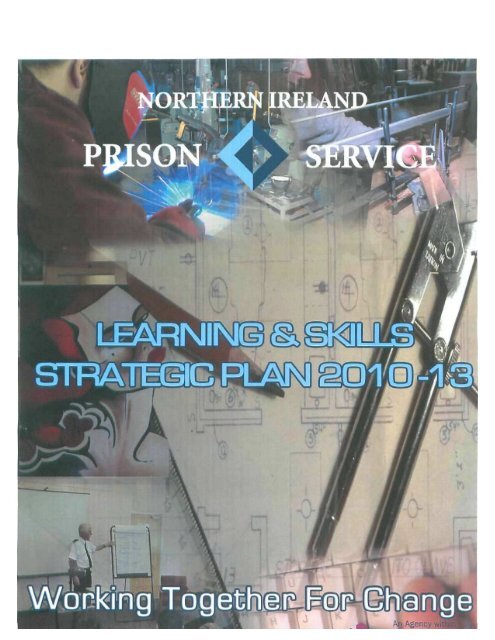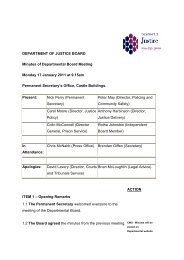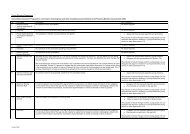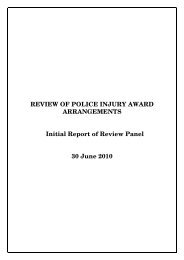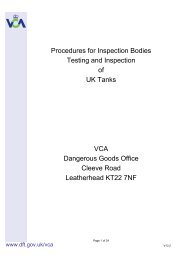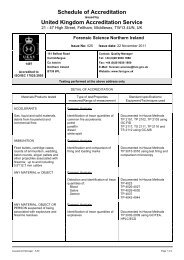Learning & Skills Strategic Plan 2010-13 - Inside Time
Learning & Skills Strategic Plan 2010-13 - Inside Time
Learning & Skills Strategic Plan 2010-13 - Inside Time
You also want an ePaper? Increase the reach of your titles
YUMPU automatically turns print PDFs into web optimized ePapers that Google loves.
INDEX<br />
Paragraph<br />
Page<br />
Foreword<br />
1 Purpose of <strong>Learning</strong> and <strong>Skills</strong> 1<br />
2 Vision 1<br />
3 Values 2<br />
4 Structure 2<br />
5 The Working Environment 3<br />
6 <strong>Plan</strong>ning assumptions 3<br />
7 Objectives 4<br />
8 Service Delivery and Results 5<br />
9 People and Development 7<br />
10 Communications and External and Internal 7<br />
Relationships with Partners and Stakeholders<br />
11 Structures, Processes and Resources 8<br />
12 Conclusion<br />
Annex<br />
A Implementation <strong>Plan</strong> Year 1 10<br />
B Implementation <strong>Plan</strong> Year 2 17<br />
C Implementation <strong>Plan</strong> Year 3 19<br />
D <strong>Learning</strong> and <strong>Skills</strong> Organisation Chart 20
WORKING TOGETHER FOR CHANGE: LEARNING AND SKILLS STRATEGIC<br />
PLAN <strong>2010</strong>-<strong>13</strong><br />
Foreword<br />
<strong>Learning</strong> and skills are important elements in some of the Prison Service's key work -<br />
preparing offenders for their return to the community and reducing re-offending.<br />
Education and employment constitute two of the nine resettlement pathways; we<br />
know that where individual's educational abilities and employability have been<br />
enhanced during their time in custody, this has a direct bearing on the likelihood of<br />
further re-offending and the creation of further victims.<br />
I very much welcome this learning and skills strategic plan. It sets out clearly, for the<br />
first time in a long while, the key aims of our education and training services, together<br />
with a major improvement plan.<br />
It is essential that there are further improvements. This is required both to enhance<br />
the current level of service delivery, and to look at better means of delivery in the<br />
current financial climate.<br />
The targets set out in the plan are challenging; rightly so. Delivery will be closely<br />
monitored. Ministers, top management in the Service and external bodies will all<br />
take a close, continuing interest in the demonstration of sustained progress.<br />
Service delivery itself is challenging. Service users in custody are often reluctant to<br />
participate, and the working environment is more challenging and less predictable<br />
than that of a further education college or an industrial setting. We know that many<br />
prisoners under-achieved at school and a significant proportion have learning<br />
disabilities or communication difficulties. However the quality of teaching, training<br />
and commitment from our staff has regularly been praised by external scrutiny<br />
bodies; I am confident there is much to build on. Indeed, significant numbers of<br />
prisoners achieve high level qualifications during their time in prison.<br />
Partnership working is vital. Within the prisons setting, learning and skills staff must<br />
liaise more closely with offender management colleagues and those in probation and<br />
health services, as well as with a wider range of public, private and non-statutory<br />
sector bodies.<br />
This plan has been developed in consultation with staff in the Service, and with many<br />
of our partner organisations. Implementation will primarily be the responsibility of<br />
Heads of <strong>Learning</strong> & <strong>Skills</strong> in each establishment, supported by <strong>Learning</strong> & <strong>Skills</strong><br />
Branch in headquarters and local management. This plan must be owned and taken<br />
forward by everyone who has a role in the delivery of learning and skills to prisoners.<br />
I commend all those who have put this plan together.
The title "Working Together for Change" reflects the themes of commitment and<br />
partnership required to drive service improvement. We will be judged on our<br />
success not only in delivering this plan but also in improving service delivery. And<br />
the best measure of that is through making a difference to the skills and abilities of<br />
offenders while they are in our custody and equipping them as best we can for return<br />
to the community.<br />
Signed<br />
Robin Masefield<br />
Director General
1. Purpose of <strong>Learning</strong> and <strong>Skills</strong><br />
1.1. In broad terms learning and skills comprise any constructive activity<br />
that leads to an increase in skills and/or educational improvement.<br />
The aim in the majority of learning and skills activity is to promote<br />
learning leading to externally recognised accreditation. A core<br />
objective in learning and skills is to improve prisoners' potential to gain<br />
employment and to promote resettlement in the community on release.<br />
1.2. Not all learning and skills activities currently fall within the remit of the<br />
formal learning and skills structure in establishments. One of the<br />
objectives in the strategic plan will be to rationalize and coordinate all<br />
learning and skills activity under the remit of establishment Heads of<br />
<strong>Learning</strong> and <strong>Skills</strong>.<br />
1.3 The core objectives of learning and skills are:<br />
> To ensure that all prisoners' educational needs are assessed<br />
and that appropriate learning and skills opportunities and activity<br />
is a key element in a positive regime;<br />
> To prepare prisoners for release and resettlement by providing<br />
the essential skills needed to participate fully in behavioural and<br />
therapeutic programmes and to engage more fully in a wider<br />
range of education and training activity;<br />
> To develop a greater sense of self-worth through participation<br />
and achievement by making learning and skills a core element<br />
of individual sentence plans ; and<br />
> To promote and provide a wide range of quality assured<br />
externally accredited courses that offer positive and exciting<br />
learning experiences for prisoners and improve future<br />
employment chances.<br />
2. Vision<br />
2.1. <strong>Learning</strong> and <strong>Skills</strong> staff support the NIPS corporate vision to be<br />
recognized as a model of good practice in dealing with prisoners and<br />
to be valued and respected for our service to the community. In<br />
particular the vision of learning and skills staff is to be recognized by<br />
prisoners, external education providers, Inspectorates and employers<br />
as a model of good practice and service provision that increases<br />
prisoners sense of self worth, skill and education levels and reduces<br />
reoffending through improved employment opportunities on release.
3. Values<br />
3.1 The values adopted by <strong>Learning</strong> and <strong>Skills</strong> build on the NIPS<br />
corporate values and have been modified to reflect our business role<br />
and objectives.<br />
> Recognizing that the Service requires the commitment of us all;<br />
> Leading well and behaving with integrity; Upholding prisoners'<br />
human rights and working with them as individuals to develop<br />
a sense of self-worth and potential through education and<br />
training;<br />
> Accepting personal responsibility and accountability for<br />
service delivery;<br />
> Working together to develop a corporate approach to learning<br />
and skills services building strong partnerships with internal<br />
and external stakeholders;<br />
> Working to develop high levels of professional competence and<br />
expertise;<br />
> Promoting, marketing and encouraging participation from<br />
prisoners and staff in learning and skills services; and<br />
> Demonstrating a commitment to fairness, equality and respect<br />
for each other and those we are in contact with that presents a<br />
positive image of the Service<br />
4. Structure<br />
4.1. <strong>Learning</strong> and <strong>Skills</strong> has undergone numerous structural changes<br />
and revisions over the years. Following a review of L&S services in<br />
2006 the provision of education and training has been brought<br />
together under a Head of <strong>Learning</strong> and <strong>Skills</strong> (HOLS) based at each<br />
of the 3 Establishments. Change has not been limited to<br />
Establishments and at Headquarters the provision of L&S now has<br />
its own discrete L&S Branch that includes a specialist <strong>Learning</strong> and<br />
<strong>Skills</strong> Advisor and will also include an Employability Advisor.<br />
4.2. The emphasis on services is moving from the traditional provision of<br />
training in construction industry skills to focus on developing skills<br />
that reflect the employment market. There is also an increasing<br />
recognition of the importance of addressing the specific needs of<br />
women prisoners, as a distinct group. In education the focus is<br />
increasingly on developing essential skills; reflecting the general low<br />
level of educational attainment amongst prisoners. The focus on
essential skills links directly to recent developments in offender<br />
management and the need for a coherent and structured sentence<br />
plan that meets the needs of individual prisoners.<br />
4.3. The organisation chart at Annex D sets out the structure of<br />
<strong>Learning</strong> and <strong>Skills</strong> at Headquarters and in Establishments on the<br />
appointment of local Heads of <strong>Learning</strong> and <strong>Skills</strong>.<br />
5. The Working Environment<br />
5.1. The strategic plan is set in the context of major changes and<br />
planned improvements to the built environment within which<br />
learning and skills services will be delivered.<br />
5.2. L&S services are developing to meet the needs of lifers in the<br />
recently opened Braid House and in preparation for the completion<br />
of a new learning and skills centre in Maghaberry due to open in<br />
late <strong>2010</strong>. In Hydebank Wood plans are being developed to improve<br />
the learning and skills accommodation for women prisoners in Ash<br />
House and to make significant renovations to the main learning and<br />
skills accommodation. Long-term plans for a new prison for<br />
sentenced prisoners offer exciting opportunities to participate in the<br />
design process for bespoke fit for purpose facilities.<br />
5.3. These changes will present a major challenge to staff to maintain<br />
current services and develop new learning and skills opportunities<br />
as the estate evolves.<br />
6. <strong>Plan</strong>ning Assumptions<br />
6.1. The following assumptions underpin the strategic plan:<br />
> The offender population will not fall below current levels and is<br />
likely to increase;<br />
> <strong>Learning</strong> & <strong>Skills</strong> (L&S) services will be delivered in a tight<br />
financial environment as NIPS is required to make ongoing<br />
savings through greater efficiency;<br />
> That the devolution of policing and justice will lead to<br />
significantly increased levels of detailed scrutiny and<br />
accountability to improve service delivery;
That L&S will position itself as a service provider supporting<br />
behavioural programmes by focusing more on essential skills<br />
and on providing accredited training in areas likely to improve<br />
prisoners employment potential and reduce offending;<br />
> That L&S will build on recent quality improvement processes<br />
Improving Quality: Raising Standards (IQRS) by setting<br />
challenging targets to improve standards;<br />
> That L&S will work to improve service delivery and widen<br />
participation by developing effective working partnerships with<br />
key internal and external stakeholders;<br />
> That current difficulties outside the direct control of L&S staff in<br />
relation to prisoner attendance and staff redeployments are<br />
resolved to ensure that services are able to run regularly and<br />
on time;<br />
> That L&S will plan to deliver services tailored to the needs of<br />
individual prisoners including those with learning disabilities<br />
and/or specific learning and communication difficulties;<br />
> That the structure of L&S is fit for purpose and that there are<br />
clear lines of responsibility and accountability for service<br />
delivery and standards of performance;<br />
> That L&S staff will have the opportunity to take advantage of<br />
relevant professional development opportunities and that this<br />
will be reflected in a corporate professional development plan;<br />
> That Nl prisons will remain a volatile and challenging working<br />
environment;<br />
> That currently projected changes to the built environment and<br />
prison population provide a realistic context for developing the<br />
service.<br />
7. Objectives<br />
7.1. The strategic plan sets out the key objectives for L&S across the 4<br />
broad areas of the NIPS Corporate <strong>Plan</strong> with some minor<br />
modifications:<br />
> Service delivery and results;<br />
> People and development;
Communications and external and internal relationships with<br />
partners and stakeholders;<br />
> Structure, processes and resources.<br />
8. Service Delivery and Results<br />
8.1. There will be a full review of current L&S service provision to test<br />
the ongoing relevance and benefits of each service against the<br />
following criteria:<br />
> Does the service meet the needs of prisoners by developing a<br />
sense of self worth and by improving educational and skills<br />
attainment through externally recognised and accredited<br />
qualifications;<br />
> Is the service viable when measured against attendance,<br />
capacity and accreditation levels but also reflecting the need to<br />
provide a broad range of relevant services to meet the distinct<br />
needs of different groups of prisoners including e.g. women<br />
prisoners, juveniles and prisoners with a learning disability<br />
and/or a learning and communication difficulty;<br />
> Are the skills and qualifications provided likely to lead to<br />
opportunities for employment, training or further education on<br />
release;<br />
> Does the service support more effective offender management<br />
by offering L&S opportunities directly linked to sentence and<br />
resettlement planning ensuring that education assessments<br />
are linked to sentence planning and intervention programmes<br />
and education levels are matched against the learning skills<br />
required to participate fully in offender behavior programmes.<br />
8.2. Each Establishment will develop a plan to address<br />
recommendations made in Inspection reports from the 4 inspection<br />
bodies (ETI, CJINI, HMCI and 1MB) or arising from a report by the<br />
Prison Ombudsman where these relate to the provision and delivery<br />
of learning and skills services.<br />
8.3. An annual evaluation of the Improving Quality and Raising<br />
Standards process will form the basis of a continuous improvement<br />
plan to be developed at each Establishment for approval by the<br />
Governor and L&S Branch.
8.4. Action <strong>Plan</strong>s will be developed to widen participation and improve<br />
the delivery of L&S to remand, female, foreign nationals and<br />
juvenile prisoners for approval by Governors and L&S Branch.<br />
8.5. An investigation will be conducted into the costs and benefits of<br />
developing positive factors that encourage prisoners to attend<br />
education and training classes.<br />
8.6. Management information collated and reported through PRISM will<br />
be developed to improve the accuracy and completeness of<br />
attendance records and to provide a reliable basis against which to<br />
assess performance and evaluate outcomes against costs.<br />
8.7. Widening participation in and the delivery of Essential <strong>Skills</strong> will be<br />
given the highest priority; and<br />
8.8. Each Establishment will develop an annual Business <strong>Plan</strong> and an<br />
associated Risk Register detailing in priority order how the strategic<br />
plan is to be delivered and resourced.<br />
8.9. A multi-agency steering group (MASG) has been working to develop<br />
and improve the delivery of appropriate L&S services to offenders in<br />
custody and in the community who have a learning disability and/or<br />
learning or communication difficulties. This represents a<br />
considerable challenge to NIPS because of the potentially high<br />
proportion of such offenders in custody and the scale of the work<br />
involved. The core issues were agreed at a "Round Table"<br />
consultation event at Hillsborough chaired by the Minister, Paul<br />
Goggins in June 2009. This has provided the template for change.<br />
Implementing the recommendations from a MASG report to<br />
Ministers to be completed around July <strong>2010</strong> will be a key element in<br />
year 1 of the strategic plan. The recommendations will focus on the<br />
4 areas of:<br />
> Screening of prisoners on committal;<br />
> Staff training;<br />
> Appropriate interventions; and<br />
> Inter-agency information sharing protocols.
9. People and Development<br />
9.1. A strategic professional development plan will be created based on<br />
agreed business needs drawn from annual business plans and staff<br />
Personal Development <strong>Plan</strong>s (PDP).<br />
9.2. Every member of staff in L&S based in establishments will have a<br />
PDP signed off by the Establishment Head of <strong>Learning</strong> and <strong>Skills</strong>.<br />
9.3. The strategic professional plan will include opportunities for staff to<br />
develop new and relevant skills and to maintain the service delivery<br />
standards required in the wider L&S environment including FE<br />
colleges where these skills directly relate to prisoner needs and<br />
approved NIPS objectives.<br />
9.4. Each Establishment will produce an annual evaluation report on<br />
learning and development activity including an assessment of how<br />
training has improved performance and service delivery.<br />
9.5. A corporate recognition process will be developed to acknowledge<br />
achievement at team and individual level.<br />
10. Communications and External and Internal Relationships with Partners<br />
and Stakeholders<br />
10.1. A corporate L&S communication policy will be developed focused<br />
on core objectives and strengthening relationships between<br />
establishments and with partners and stakeholders.<br />
10.2. A cross-cutting group will be established at each prison bringing<br />
together representatives from key internal and external partners<br />
and stakeholders (see year 1 implementation plan) where there is<br />
a clear inter-dependence for effective service delivery. The group<br />
will be chaired by the Head of L&S at each establishment and will<br />
focus on improving coordination and service delivery.<br />
10.3 A corporate marketing strategy will be developed to promote<br />
wider participation in L&S.<br />
10.4. Establishment Heads of <strong>Learning</strong> and <strong>Skills</strong> will participate fully as<br />
members of the Governors' senior management team.<br />
10.5. An employability strategy will be developed linking L&S services<br />
to employment market trends and opportunities.
10.6. As the IT Strategy is implemented greater use will be made of IT<br />
as an educational source and archive to record, share and report<br />
on L&S services and outcomes. Information will be recorded and<br />
shared on education assessments, referrals from and to partner<br />
bodies (internal and external) for interventions and to<br />
systematically record a prisoners L&S progression against agreed<br />
sentences plans.<br />
10.7. An engagement strategy with prisoners' families will be developed<br />
to promote interest and uptake of L&S services and to encourage<br />
families to actively support involvement in education and training.<br />
11. Structures, processes and resources<br />
11.1. L&S Branch will lead a corporate approach to resource planning<br />
and allocation ensuring that resource needs align with business<br />
needs and are supported by detailed business plans.<br />
11.2. A revised sale of goods policy will be introduced ensuring<br />
effective governance arrangements are in place and regulating<br />
the arrangements for the sale of goods to internal and external<br />
customers.<br />
11.3. Discussions will be initiated with senior management on how<br />
resources allocated to L&S can be protected to ensure effective<br />
and reliable service delivery and attendance.<br />
12. Conclusion<br />
12.1. The absence of a corporate strategic planning process has been a<br />
significant impediment to service growth and delivery. The<br />
absence of corporate L&S objectives and associated performance<br />
measures has made it difficult to both recognize our successes or<br />
to hold us to account for service failures both at individual<br />
establishment level to the Governor and at a corporate level.<br />
12.2. Effective corporate governance requires clear lines of delegation<br />
and accountability. The strategic plan assigns roles and<br />
responsibilities against specified objectives and provides the<br />
means to measure success. Most importantly it establishes and<br />
facilitates a partnership approach to L&S service delivery that is<br />
currently absent.
12.3. Partnership involves collaboration in a joint venture where we<br />
work collectively to achieve shared objectives. Success will<br />
depend on the strength of our partnerships with prison staff and a<br />
wide range of internal (e.g. Offender Management/Resettlement<br />
staff, Prison Psychology, Prison Healthcare, prisoners) and<br />
external groups (e.g. Niacro Jobtrack, Extern, Duke of Edinburgh<br />
Award Scheme, FE Colleges, voluntary sector groups).<br />
12.4. Implementing the objectives in the strategic plan will strengthen<br />
corporate governance by establishing service level agreements,<br />
regularizing financial planning, monitoring, evaluating and<br />
reporting of performance and by holding us all to account for the<br />
delivery of assigned responsibilities.<br />
12.5. Implementation <strong>Plan</strong>s are attached setting out the objectives, lead<br />
responsibility for delivery, partners, deadlines and performance<br />
targets for each year of the strategic plan. The plan will role<br />
forward adding a new final year as the first year concludes. It will<br />
evolve as its implementation is monitored and evaluated.<br />
Consequently new objectives and performance targets will arise<br />
and old targets will be revised. This is the norm in an effective<br />
planning process. Staff and relevant partners will be consulted<br />
and their views taken into account as the plan progresses.<br />
25 March <strong>2010</strong>
<strong>Learning</strong> and <strong>Skills</strong> Strategy <strong>2010</strong>-<strong>13</strong>: - Implementation <strong>Plan</strong><br />
ANNEX A<br />
Yeari: <strong>2010</strong>-11<br />
Objective Lead Role Partners Stakeholders Performance<br />
Measures<br />
1. Review of current HOLS Prison Staff Prisoners • L&S services<br />
services against L&S Branch Families align with and<br />
performance Jobtrack Employers support<br />
criteria OMG FE Colleges sentence<br />
PAF Accreditation planning and<br />
Psychology Bodies included in a<br />
DEL service level<br />
Duke of agreement<br />
Edinburgh's<br />
Award<br />
between L&S<br />
and OMG;<br />
• Education<br />
assessments<br />
completed to<br />
meet offender<br />
management<br />
and sentence<br />
planning<br />
deadlines;<br />
• 90% of courses<br />
leading to<br />
externally<br />
recognized<br />
accreditations;<br />
• Service is cost<br />
effective and<br />
can be<br />
delivered within<br />
existing<br />
resources,<br />
enrolment is<br />
80% of<br />
capacity and<br />
average<br />
attendance<br />
levels of 60%<br />
against<br />
enrolment<br />
achieved;<br />
• ES (literacy<br />
and numeracy)<br />
enrollments<br />
increase 10%<br />
above 2009<br />
10
Objective<br />
Lead Role<br />
Year 1:<strong>2010</strong>-11<br />
Partners Stakeholders Performance<br />
Measures<br />
levels;<br />
• ES average<br />
attendance<br />
increase 20%<br />
against 2009<br />
levels;<br />
• Embedded ES<br />
included by<br />
year end in<br />
35% of all<br />
recreational<br />
educational<br />
and training<br />
courses;<br />
• Current DEL<br />
funded FE<br />
College ES<br />
provision is<br />
maintained in<br />
Magilligan and<br />
increased in<br />
Maghaberry<br />
and HBW;<br />
• Prisoner and<br />
employer<br />
satisfaction<br />
levels with<br />
accreditation<br />
type and level<br />
measured<br />
annually;<br />
• 25% of<br />
prisoners who<br />
complete the<br />
Jobtrack<br />
Programme<br />
gain<br />
employment or<br />
training places<br />
on release;<br />
statistics<br />
maintained on<br />
post release<br />
employment<br />
levels to inform<br />
future targets;<br />
> A programme
Year 1:<strong>2010</strong>-11<br />
Objective Lead Role Partners Stakeholders Performance<br />
Measures<br />
of ES and<br />
cognitive thinking<br />
courses developed<br />
in consultation with<br />
OMU by September<br />
<strong>2010</strong> to maximize<br />
prisoners capacity to<br />
participate fully in<br />
behavioural and<br />
therapeutic<br />
programmes; •<br />
Review completed<br />
(October <strong>2010</strong>).<br />
2. Implement<br />
recommendations from<br />
MASG on <strong>Learning</strong><br />
Disability and <strong>Learning</strong><br />
and Communications<br />
Difficulties<br />
L&S Branch<br />
HOLS Prison<br />
Staff Multi-<br />
Agency Steering<br />
Group on<br />
<strong>Learning</strong><br />
Disability and<br />
<strong>Learning</strong> and<br />
Communication<br />
Difficulties<br />
<strong>Learning</strong> and<br />
<strong>Skills</strong> Forum<br />
Information<br />
Sharing Sub-<br />
Group<br />
Prisoners<br />
Families<br />
• MASG Report to<br />
PSMB and Ministers<br />
(Sept <strong>2010</strong>); •<br />
Implement new<br />
screening, training,<br />
interventions and<br />
information sharing<br />
arrangements<br />
(March 2011).<br />
3. Each Establishment<br />
develops a <strong>2010</strong>-11<br />
Business <strong>Plan</strong> based<br />
on the <strong>Strategic</strong> <strong>Plan</strong><br />
HOLS<br />
L&S Branch<br />
Prison staff<br />
PAF FE<br />
Colleges<br />
Jobtrack<br />
Duke of<br />
Edinburgh's<br />
Award<br />
Prisoners<br />
Employers<br />
FE Colleges<br />
Inspection<br />
Bodies<br />
• Consultation on<br />
draft business plans<br />
(July-Aug<strong>2010</strong>): •<br />
Business <strong>Plan</strong>s<br />
approved and<br />
resources allocated<br />
on priority basis<br />
(Sept <strong>2010</strong>); •<br />
Quarterly<br />
monitoring of<br />
implementation in<br />
June,<br />
12
Year: <strong>2010</strong>-11<br />
Objective Lead Role Partners Stakeholders Performance<br />
Measures<br />
September,<br />
December and<br />
March.<br />
4. Improving Quality and<br />
Raising Standards<br />
HOLS L&S<br />
Branch<br />
PAF FE<br />
Colleges<br />
Accreditation<br />
Bodies<br />
Prison Staff<br />
Prisoners<br />
Inspection<br />
Bodies<br />
• Review and<br />
revise initial<br />
standards and<br />
targets (April <strong>2010</strong>);<br />
• Develop 3-year<br />
continuous<br />
improvement plan<br />
(July-Sept <strong>2010</strong>)<br />
5. Introduce revised sale<br />
of goods policy<br />
L&S Branch<br />
HOLS NIPS<br />
Finance Branch<br />
Prison Staff<br />
Prisoners<br />
Families<br />
Approved<br />
charities<br />
• Policy<br />
implemented (April<br />
<strong>2010</strong>); •<br />
Accounting<br />
arrangements in<br />
place to check<br />
invoices against<br />
payments on a<br />
quarterly basis<br />
(June, Sept, Dec<br />
and March)<br />
6. Action <strong>Plan</strong>s to<br />
widen participation<br />
HOLS<br />
L&S Branch<br />
Prison Staff<br />
PAF Duke of<br />
Edinburgh's<br />
Award FE<br />
Colleges<br />
Prisoners<br />
Families<br />
• Specific action<br />
plans developed<br />
for sentenced,<br />
remands, female<br />
and juvenile<br />
prisoners to market<br />
services, promote<br />
involvement and<br />
present benefits<br />
(Sept <strong>2010</strong>); •<br />
Joint JJC and<br />
HBW action plan<br />
agreed to improve<br />
cooperation,<br />
<strong>13</strong>
Year 1:<strong>2010</strong>-11<br />
Objective Lead Role Partners Stakeholders Performance<br />
Measures<br />
planning,<br />
service delivery.<br />
Information sharing<br />
and research on<br />
what works (April<br />
<strong>2010</strong>); • Identify<br />
the costs and<br />
benefits of<br />
introducing<br />
common financial<br />
incentives for all<br />
prisoners attending<br />
L&S courses<br />
(June-Sept <strong>2010</strong>).<br />
7. Establishment Crosscutting<br />
L&S Steering<br />
Groups<br />
HOLS<br />
L&S Branch<br />
PAF Prison<br />
Staff Prison<br />
Healthcare<br />
Psychology<br />
Jobtrack<br />
Extern Duke<br />
of<br />
Edinburgh's<br />
Award OMG<br />
Prisoners<br />
Families FE<br />
Colleges<br />
Accreditation<br />
Bodies<br />
• HOLS included<br />
in Governor's senior<br />
management team<br />
(April <strong>2010</strong>); • TOR<br />
agreed by group at<br />
first meeting (July-<br />
Aug<strong>2010</strong>); •<br />
Action plan<br />
developed to<br />
improve<br />
cooperation,<br />
coordination and<br />
service delivery<br />
(Sept <strong>2010</strong>); •<br />
Steering Group<br />
meets monthly to<br />
review progress and<br />
evaluate outcomes.<br />
8. Employability<br />
Strategy<br />
L&S Branch<br />
HOLS<br />
Cross-cutting<br />
L&S Steering<br />
Groups Prison<br />
Staff<br />
Prisoners<br />
Families<br />
Employers<br />
DEL<br />
Employability<br />
Advisor recruited<br />
in L&S Branch
Year 1:<strong>2010</strong>-11<br />
Objective Lead Role Partners Stakeholders Performance<br />
Measures<br />
DEL Career<br />
Advice Service<br />
FE Colleges<br />
Accreditation<br />
Bodies<br />
(Dec <strong>2010</strong>); •<br />
Consultation on<br />
draft Employability<br />
Strategy (Dec <strong>2010</strong>-<br />
Feb 2011): •<br />
Strategy introduced<br />
(March 2011).<br />
9. Implementation of IT<br />
Strategy<br />
L&S Branch<br />
HOLS IT<br />
Support<br />
Prison Staff<br />
Prisoners<br />
• IT Steering<br />
Group will continue<br />
to oversee the<br />
implementation of<br />
the 5-year IT<br />
Strategy supported<br />
by IT coordinators<br />
at each<br />
Establishment; •<br />
Quarterly progress<br />
reports will be<br />
prepared and<br />
circulated by the<br />
Chairperson of the<br />
IT Steering Group<br />
(June, Sept, Dec<br />
and March)<br />
10. Review PRISM<br />
accuracy and report<br />
formats<br />
HOLS<br />
L&S Branch<br />
Prison Staff<br />
PAF FE<br />
Colleges DEL<br />
• Identify and<br />
address causes of<br />
inaccurate reporting<br />
(April-May <strong>2010</strong>); •<br />
Develop and<br />
implement revised<br />
reporting formats<br />
(July <strong>2010</strong>) • 6-<br />
monthly review of<br />
PRISM<br />
15
Year 1:<strong>2010</strong>-11<br />
Objective Lead Role Partners Stakeholders Performance<br />
Measures<br />
accuracy (Sept<br />
and March).<br />
11. Corporate approach<br />
to financial planning<br />
and budgeting<br />
L&S Branch<br />
HOLS Prison<br />
Staff NIPS<br />
Finance Branch<br />
PAF<br />
FE Colleges<br />
DEL<br />
• Process of<br />
quarterly monitoring<br />
of expenditure<br />
against budgets and<br />
forecast introduced<br />
(June, Sept, Dec and<br />
March); • Financial<br />
plans and bids for<br />
next financial year<br />
submitted to L&S<br />
Branch and<br />
Governors for<br />
approval (December<br />
<strong>2010</strong>); • L&S<br />
budget bids agreed<br />
(January 2011).<br />
16
<strong>Learning</strong> and <strong>Skills</strong> Strategy <strong>2010</strong>-<strong>13</strong>: - Implementation <strong>Plan</strong><br />
ANNEX B<br />
Year 2: 2011-12<br />
Objective Lead Role Partners Stakeholders Performance<br />
Measures<br />
1. Family L&S Branch HOLS Prisoners • Questionnaire<br />
Engagement Prison Family Extern issued to<br />
Strategy Officers Niacro survey views of<br />
Prison staff<br />
family visitors<br />
Resettlement<br />
on L&S<br />
Branch<br />
services (May<br />
Quakers 2011);<br />
Centre<br />
• Action <strong>Plan</strong><br />
Duke of<br />
introduced to<br />
Edinburgh's<br />
Award<br />
widen family<br />
participation<br />
and support for<br />
L&S delivery<br />
(June-Sept<br />
2011).<br />
2. Professional staff HOLS PSC Prisoners • Professional<br />
development plan L&S Branch PAF Development<br />
in place FE Colleges Prison Staff <strong>Plan</strong> approved<br />
CAL<br />
L&S staff<br />
by L&S Branch<br />
and Governors<br />
(June 2011);<br />
• Evaluation<br />
process<br />
implemented<br />
(August 2011);<br />
• End year<br />
evaluation<br />
report<br />
completed<br />
(March 2011).<br />
3. Corporate L&S Branch HOLS : L&S Staff • Consultation<br />
Recognition and Prison Staff PAF document<br />
Reward Scheme NIPS FE Colleges issued<br />
Personnel<br />
proposing<br />
process,<br />
performance<br />
standards and<br />
awards criteria<br />
(October 2011);<br />
17
Year 2: 2011-12<br />
Objective Lead Role Partners Stakeholders Performance<br />
Measures<br />
Agreed policy<br />
introduced (March<br />
2011);<br />
•<br />
4. Corporate<br />
Communication<br />
Policy<br />
L&S Branch<br />
HOLS<br />
PAF Prison<br />
Staff OMG<br />
Psychology<br />
Prison<br />
Healthcare<br />
PBNI<br />
Jobtrack<br />
Prisoners FE<br />
Colleges DEL<br />
Accreditation<br />
Bodies<br />
Families Duke<br />
of Edinburgh's<br />
Award<br />
• Policy drafted<br />
for consultation<br />
(June 2011); •<br />
Agreed policy<br />
introduced (Sept 1<br />
2011).<br />
5. L&S Staff and<br />
Budgets Ring<br />
fenced<br />
L&S Branch<br />
HOLS Prison<br />
Staff NIPS<br />
Personnel<br />
PAF FE<br />
Colleges DEL<br />
• Consultation on<br />
potential<br />
arrangements to<br />
introduced ringfenced<br />
budgets and<br />
staffing (April 2011);<br />
• Report on<br />
agreed process<br />
issued and<br />
implemented (Aug-<br />
Sept 2011).<br />
6. Fundamental Review<br />
of L&S Service<br />
Provision<br />
Arrangements<br />
L&S Branch<br />
HOLS L&S<br />
Staff Prison<br />
Staff NIPS<br />
Senior<br />
Management<br />
Cross-cutting<br />
Steering<br />
Groups<br />
FE Colleges<br />
DEL<br />
Prisoners<br />
• Consultation on<br />
options for future<br />
shape of L&S<br />
services (June 2011)<br />
• Conference to<br />
consider option for<br />
future service<br />
delivery (October<br />
2011); • Way<br />
Forward proposals<br />
issued (Jan-March<br />
2012).<br />
18
<strong>Learning</strong> and <strong>Skills</strong> Strategy <strong>2010</strong>-<strong>13</strong>: - Implementation <strong>Plan</strong><br />
ANNEXC<br />
Year 3: 2012-<strong>13</strong><br />
Objective Lead Role Partners Stakeholders Performance<br />
Measures<br />
1. Way Forward L&S Branch HOLS FE Colleges • L&S model<br />
Proposals L&S Staff implemented<br />
Introduced Prison Staff DEL (September<br />
NIPS Senior<br />
Management Prisoners<br />
2012)<br />
Cross-cutting<br />
Steering<br />
Groups<br />
Nipsa<br />
POA<br />
19
priz'n'press<br />
Resettle men I Unit Fey I e view<br />
H.M Prison Magilkgan<br />
Point Road<br />
Limavady<br />
BT49 OLR<br />
023 7772 059B
ANNEX D<br />
Robin Masefield<br />
Director General<br />
I<br />
Director Operation<br />
Colin McConnell<br />
_L<br />
D/Director of Operations<br />
Alan Craig<br />
Pat Maguire<br />
Governor Maghaberry<br />
_L<br />
Tom Woods<br />
Governor Magilligan<br />
Gary Alcock<br />
A/Governor Hydebank<br />
Head of <strong>Learning</strong> &<br />
<strong>Skills</strong> Branch HQ<br />
Governor for<br />
<strong>Learning</strong> & <strong>Skills</strong><br />
Governor for<br />
<strong>Learning</strong> & <strong>Skills</strong><br />
Governor for<br />
<strong>Learning</strong> & <strong>Skills</strong><br />
Head of <strong>Learning</strong> &<br />
<strong>Skills</strong><br />
Head of <strong>Learning</strong> &<br />
<strong>Skills</strong><br />
Head of <strong>Learning</strong> &<br />
<strong>Skills</strong><br />
Teachers Instructors Teachers<br />
1<br />
Instructors<br />
Teachers<br />
JL<br />
Instructors


